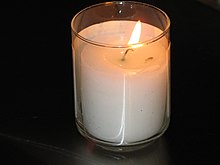Year time
The year (in Switzerland sometimes also the year) or the anniversar (plural anniversaries , from the Latin anniversarium ) denotes the ritual celebration of the day of death of a believer. Initially, birthdays and accession to the throne of rulers were primarily celebrated as anniversaries , but from the Middle Ages onwards it became customary to celebrate the day of death as a “birthday in heaven”. Common terms for it today are also annual memory , annual memory or annual office .
Christianity
Based on the feast days of Christian saints and martyrs , the custom arose as early as the early Middle Ages to commemorate special deceased on the day of their death in Holy Mass ( memorial system ). In addition to the anniversaries of important ecclesiastical and secular dignitaries, those of the abbots and monks were also occasionally celebrated in monastic communities . Several spiritual institutions arranged among themselves via prayer fraternities that they would celebrate the anniversaries of all persons involved.
The basis for the commemoration was usually a foundation ( Seelgerät , "eternal mass"), which had been set up either as a precautionary measure by those affected themselves or by their descendants. From the 12th century , such "foundations for salvation " (Karl Schmid) increased enormously. The implementation of the doctrine of purgatory may be partly responsible for this increase. In order to keep up to date with the growing number of memorial services, monasteries and monasteries began to record the names of the deceased donors under the date of their death in calendar necrology or year books . From the 15th century at the latest, most of the parish churches as well as individual hospitals and infirmaries kept corresponding registers, which prove the enormous spread of this tradition. For the Latin anniversarium , the Middle High German equivalent jarzyt became established in the 14th century .
While the reformers declared the intercession to be ineffective and therefore abolished the seasonal system, this flourished again in Catholic regions in the early modern period and especially after the Council of Trent , which in some cases lasted into the 20th century. It was not until the end of the 20th century that it was decided in many places that the seasons should no longer be kept forever , but limited to 15, 20 or a maximum of 25 years.
In medieval documents, the local aristocratic ruler often donates a so-called anniversary . This is analogously to the process described above with the year .
Judaism
The year time ( Yiddish Jorzajt יאָרצײַט or Yahrtzeit , יאָרצײַט) is also observed in Judaism . Their date is based on the Jewish calendar . Through the Yiddish, the old German term Yahrtzeit has become common among all Ashkenazim . The celebration of the year includes speaking the kaddish , visiting the grave (if possible) and lighting a candle that burns for 24 hours ( year light ). The memory of the deceased since preserved medieval in Memorbüchern .
The grave of David Ben-Gurion , along with his wife. His grave is covered with year candles.
Standard Israeli military graves of David Elazar , Jonathan Netanyahu and others with year-time candles.
Rabbi Shlomo Carlebach's grave with year light
Six year candles in Pearl Harbor (2007) - for Shoah Remembrance Day at the "Sharkey Theater" on board Naval Station Pearl Harbor.
See also
literature
- W. Dürig: Anniversaries . In: Lexicon of the Middle Ages (LexMA). Volume 1, Artemis & Winkler, Munich / Zurich 1980, ISBN 3-7608-8901-8 , column 665 f.
- Peter Erhart, Jakob Kuratli Hüeblin (ed.): Books of life - living books. Catalog for the exhibition in the government building of the Canton of St. Gallen, St. Gallen 2010.
- Rainer Hugener: Bookkeeping for eternity. Remembrance of the dead, written down and tradition formation in the late Middle Ages. Chronos, Zurich 2014, ISBN 978-3-0340-1196-9 .
- Peter-Johannes Schuler: The Anniversar. On mentality and family awareness in the late Middle Ages . In the S. (Ed.): The family as a social and historical association. Investigations into the late Middle Ages and early modern times . Sigmaringen 1987, pp. 67-117.
- Karl Schmid: Foundations for salvation . In the S. (Ed.): Memory that creates community . Munich / Zurich 1985, pp. 51-73.
Web links
- Entry in the Reallexicon of German Antiquities from 1885
- Information and year-time calculator from Chabad
- Annual toboggan of the Hütten chapel, 1496






